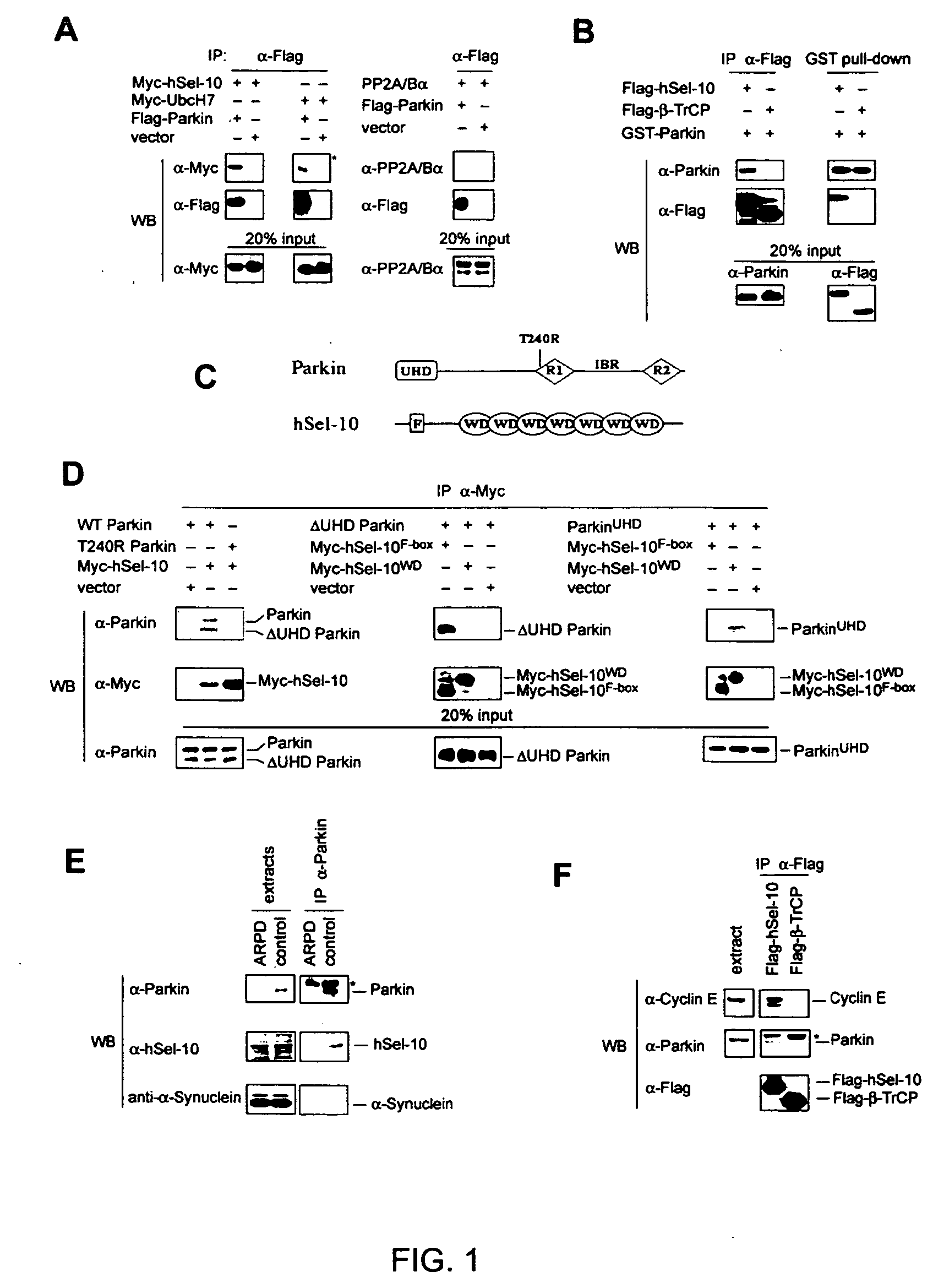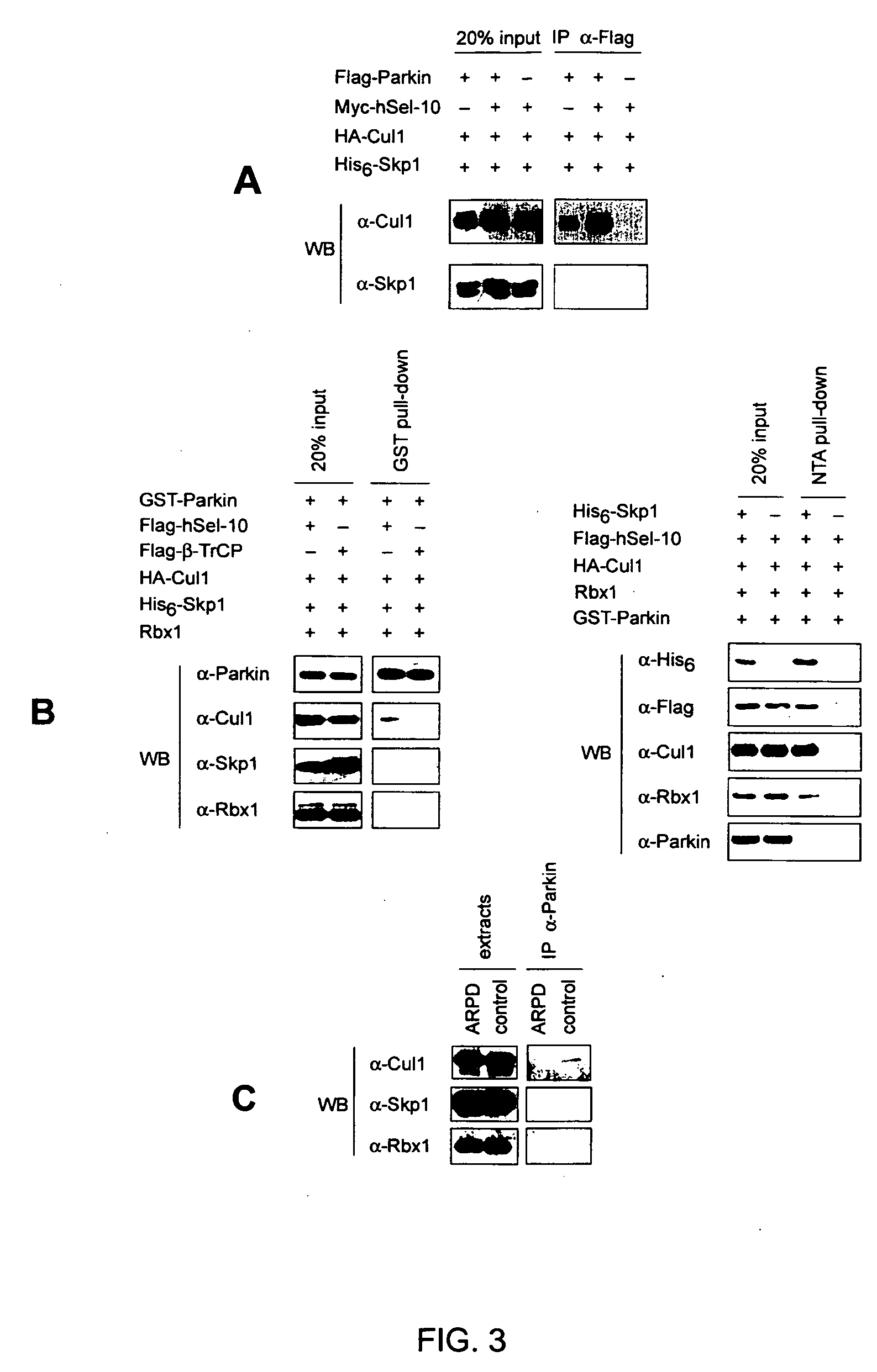Protecting cell therapy for neurological disorders including Parkinson's disease
- Summary
- Abstract
- Description
- Claims
- Application Information
AI Technical Summary
Benefits of technology
Problems solved by technology
Method used
Image
Examples
example 1
Expression Vectors, Cell Cultures and Antibodies
[0121] cDNAs for parkin, UbcH7, α-synuclein, and UbcH8 were PCR-amplified from a human liver cDNA library (Clontech), and cloned into the eukaryotic expression vectors, pCMS-EGFP (Clontech) or pcDNA3.1. Flag-parkin, T240R parkin, Flag-T240R parkin, and ΔUHD parkin were generated by PCR-mediated mutagenesis. A cDNA clone encoding PP2A / Bα was obtained from Research Genetics. HSel-10 constructs have been described (Wu et al., SEL-10 is an inhibitor of Notch signaling that targets Notch for ubiquitin-mediated protein degradation. Mol. Cell Biol., 21:7403-15, 2001). The integrity of all constructs was confirmed by automated sequencing. Recombinant baculoviruses expressing GST-tagged parkin were generated using the Baculogold system (Pharmingen), as per the manufacturer's instructions.
[0122] HeLa cells were maintained in Dulbecco's Modified Eagle Medium (Life Technologies), supplemented with 10% fetal bovine serum (Life Technologies), and...
example 2
Generation of DJ-1 Deficient ES Cells
[0162] To investigate the normal cellular function of DJ-1 and the pathogenic mechanism of the PD mutations, the inventors generated cells deficient in DJ-1. A murine embryonic stem (ES) cell clone, F063A04, that harbors a retroviral insertion at the DJ-1 locus was obtained through the German Gene Trap Consortium (Tikus web site) (Floss and Wurst 2002). The pT1ATGβgeo gene trap vector is present between exons 6 and 7 of the murine DJ-1 gene, as determined by cDNA sequencing of trapped transcripts and genomic analysis (FIG. 1A). This integration is predicted to disrupt the normal splicing of DJ-1, leading to the generation of a truncated protein that lacks the carboxy-terminal domain required for dimerization and stability (data not shown). Of note, a mutation that encodes a similarly truncated protein (at the human DJ-1 exon 7 splice acceptor) has been described in a patient with early-onset PD (Hague et al. 2003).
[0163] To select for ES subcl...
example 3
DJ-1 Lacks Apparent Protease and Antioxidant Activities In Vitro
[0183] DJ-1 homologs have been reported to harbor protease (Halio et al. 1996; Du et al. 2000; Lee et al. 2003) and amidotransferase activities (Horvath and Grishin 2001). However, crystal structure analyses of DJ-1 suggest that this protein may not retain such catalytic activities (Honbou et al. 2003a; Huai et al. 2003; Lee et al. 2003; Tao and Tong 2003; Wilson et al. 2003). Consistent with this, purified DJ-1 preparations failed to display in vitro protease activity toward a variety of synthetic or natural substrates, and, similarly, DJ-1 lacked antioxidant (FIG. 32) or catalase activities (FIG. 28) in vitro. Furthermore, cells deficient in DJ-1 appear unaltered in the initial accumulation of ROS in the context of acute oxidative stress (Martinat et al. 2004).
DJ-1 Is a Redox-Dependent Molecular Chaperone
[0184] Every organism responds to ROS and other toxic environmental stresses by overexpressing a highly conser...
PUM
| Property | Measurement | Unit |
|---|---|---|
| Structure | aaaaa | aaaaa |
| Fluorescence | aaaaa | aaaaa |
Abstract
Description
Claims
Application Information
 Login to View More
Login to View More - R&D
- Intellectual Property
- Life Sciences
- Materials
- Tech Scout
- Unparalleled Data Quality
- Higher Quality Content
- 60% Fewer Hallucinations
Browse by: Latest US Patents, China's latest patents, Technical Efficacy Thesaurus, Application Domain, Technology Topic, Popular Technical Reports.
© 2025 PatSnap. All rights reserved.Legal|Privacy policy|Modern Slavery Act Transparency Statement|Sitemap|About US| Contact US: help@patsnap.com



